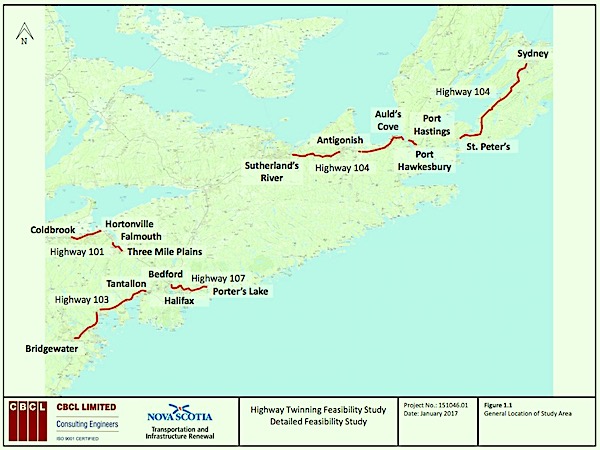
22 Feb Twinning past the graveyard
I attended the highway twinning discussion in Sydney Tuesday night, one of a dozen sessions the Department of Transportation and Infrastructure Renewal is holding around the province to gauge support for highway tolls as a way to speed up seven highway twinning projects on the department’s wish list.
The core question: should we finance these highway projects in the normal way, out of gasoline taxes, in which case they will take decades, or by implementing tolls on our 100-series highways to generate revenue that would support much faster construction through public-private partnerships.
The department came armed with a detailed feasibility study from the engineering firm CBCL. It evaluates the seven sections of highway based on cost—a total of 2.4 billion—and potential reductions in collisions and travel times. A power point presentation summarized the results and posed questions for the public.
I make 20-25 round trips a year from Cape Breton to Halifax, another 100 or more trips to Sydney from my Victoria County abode. I much prefer driving on divided highways. I still don’t think we should do any more twinning, any time soon.
Nova Scotia has neglected highway and bridge maintenance for decades. Successive governments found it politically more palatable to rein in the province’s third-largest budget item, Transportation, than numbers. 1 & 2, Health and Education. Over the last half century, inadequate transportation budgets have produced a growing backlog of deferred maintenance and construction.
In 2001, the department carried out a study to gauge the size of this infrastructure deficit. It found the province needed to spend $3.4 billion in highway and bridge repairs and construction over the ensuing 10 years. Budgets increased slightly, but not enough to eat away at the shortfall. When the department took a second look at the infrastructure deficit in 2008, it found the total had grown to $4.38 billion.
Nine years have passed since that report, and we continue to spend at about half the rate required to reduce the maintenance and construction backlog. How big is the shortfall today: $5 billion? $6 billion? Who knows?
Faced with this ever-growing deficit, why would we suddenly go another $2.4 billion into hock to build new roads when we can’t adequately maintain the ones we have?
Been to Europe lately? By comparison, Nova Scotia roads are an embarrassment of ragged asphalt and crumbling curbs. Many, especially those used by heavy coal-hauling trucks, are badly rutted. Personally, I would rather drive in a snowstorm than in heavy rain on a rutted highway. In a snowy skid, I know how to regain control of a vehicle, but when a car hydroplanes, it’s strictly Jesus Take the Wheel.
My logic holds no appeal to politicians. Tell constituents you’re going to spend $1 billion to twin a nearby highway, and they’ll elect you again and again. Tell them you’re going to spend $1 billion patching potholes, and watch them yawn.
We are a large province with a small population. Our roads are lightly travelled by 21st century standards. They are much safer than they were 20 years ago. Traffic deaths have fallen sharply over that period. There are a multitude of steps we can take to make them even safer, such as rumble strips, reflective line markings, and prompt attention to the worst of the truck-induced rutting.
A $2.4 billion spending spree may or may not make us safer; it will surely make us poorer.

